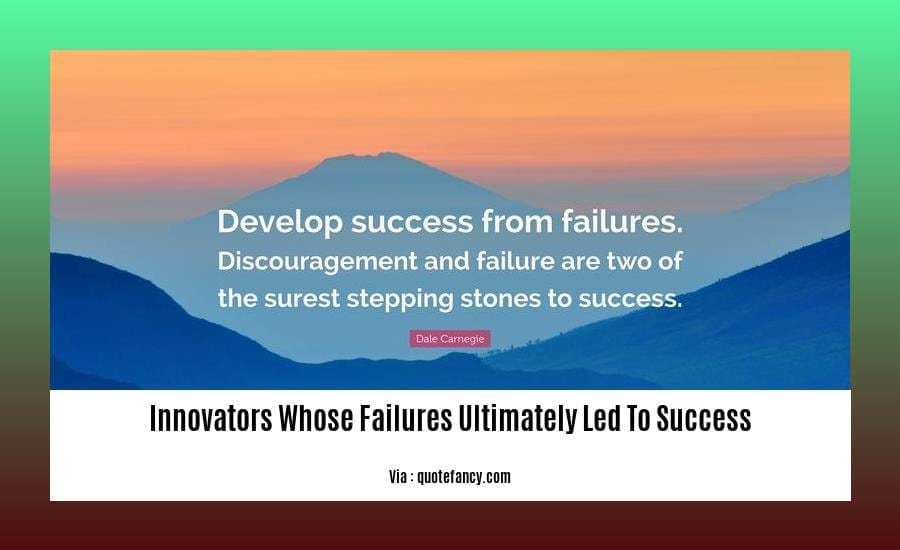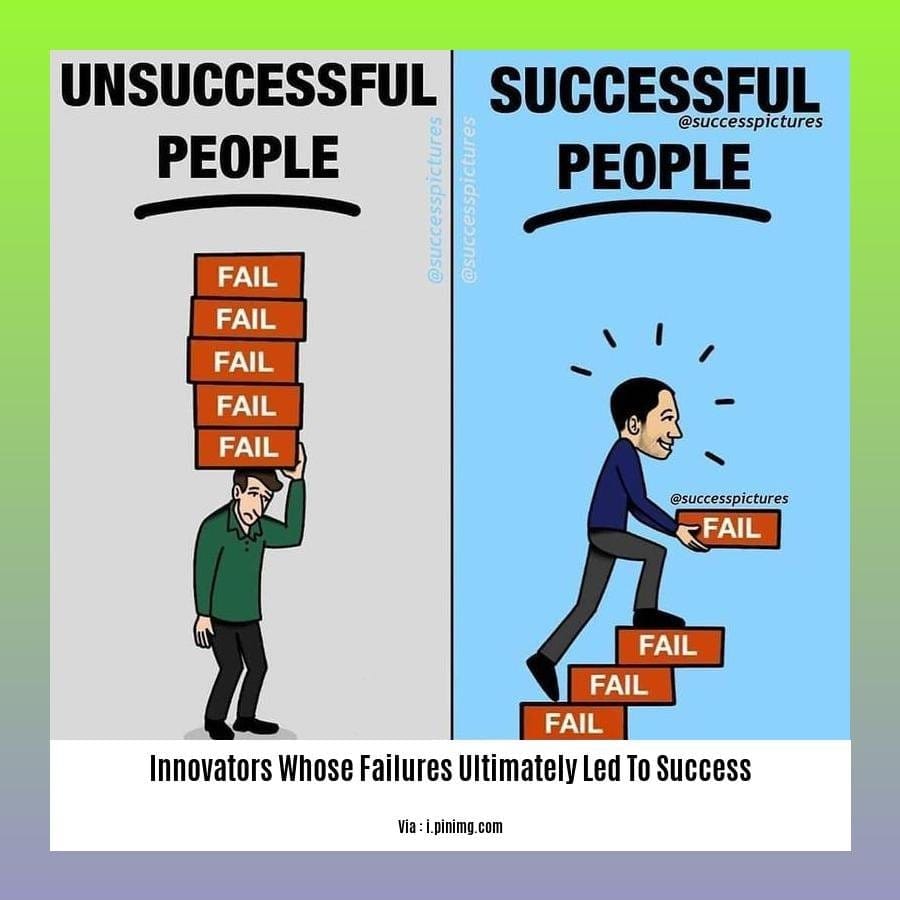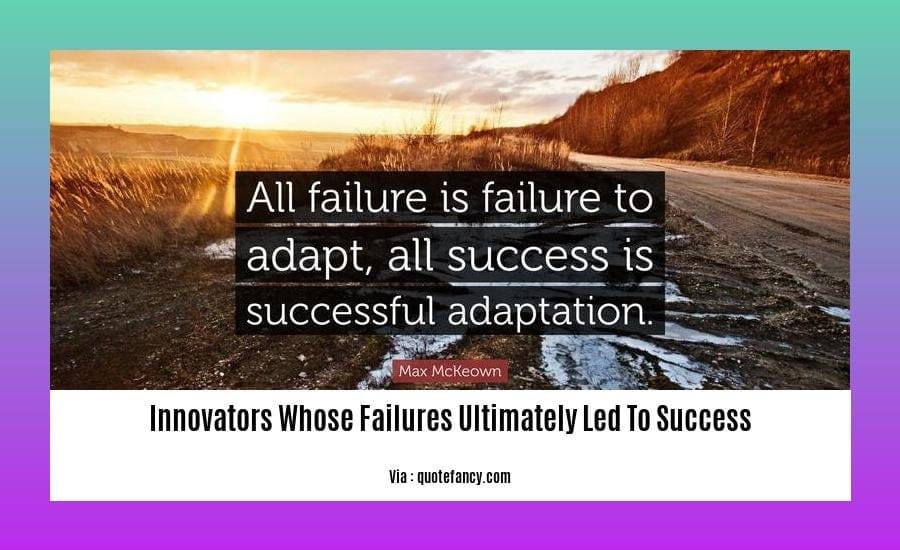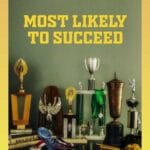The stories of legendary innovators Sir James Dyson, Henry Ford, Walt Disney, and Robert Goddard are testaments to the transformative power of perseverance in the face of setbacks. These icons’ journeys towards groundbreaking achievements were far from straightforward, paved with countless failures that ultimately became the catalysts for their greatest triumphs.
Key Takeaways:

- Failure drives success for innovators like Steve Jobs, Oprah Winfrey, Elon Musk, and J.K. Rowling.
- Innovation arises from failure and learning from setbacks.
- Failure-embracing organizations foster innovation by supporting employees who share experiences.
- Failure analysis and viewing setbacks as stepping stones to success are crucial for learning.
- Persistence leads to success, as shown by inventors like James Dyson, Walt Disney, and Alexander Graham Bell despite numerous failures.
Innovators Whose Failures Ultimately Led to Success
In the world of innovation, failures are not roadblocks but stepping stones to success. History is replete with the stories of innovators whose failures ultimately led to success. These individuals dared to fail, learned from their mistakes, and ultimately triumphed.
Think of Steve Jobs, the enigmatic co-founder of Apple. His relentless pursuit of perfection led to numerous setbacks, including the infamous firing from his own company. Yet, he persevered, returning to Apple and leading it to unprecedented heights.
Walt Disney, the visionary behind the beloved Disney empire, faced countless rejections and financial struggles. His early cartoons were failures, but he never gave up, eventually creating the iconic Mickey Mouse and building a global entertainment behemoth.
The list of such innovators whose failures ultimately led to success is long and inspiring. Alexander Graham Bell’s initial attempts at the telephone were met with skepticism, but he remained undeterred and eventually revolutionized communication. Thomas Edison, known for his relentless experimentation, failed thousands of times before successfully inventing the light bulb.
These stories teach us that failure is not a sign of weakness but an intrinsic part of the innovation process. By embracing failure, innovators whose failures ultimately led to success have laid the groundwork for our technological advancements, entertainment, and countless other breakthroughs. They remind us that the path to success is paved with setbacks, but it is through those struggles that true innovation is born.
From pioneers whose early stumbles birthed breakthroughs and flops that became precursors to pioneering hits to visionaries whose persistence trumped setbacks, history is replete with innovators whose failures ultimately led to success.
Walt Disney: Overcoming Obstacles and Embracing Failures
Despite Walt Disney’s remarkable success, his journey was not without its trials and tribulations. Let’s explore some of the key obstacles he faced, and how he turned failures into stepping stones for greatness:
Troubled Beginnings
Walt Disney’s childhood was marked by a strict father and financial hardship. These challenges instilled in him a strong work ethic and resilience, traits that would serve him well in his later life.
Financial Setbacks
Walt Disney’s first venture, Laugh-O-Gram Films, went bankrupt, leaving him penniless and devastated. Undeterred, he relocated to Hollywood and started again, this time with the iconic Mickey Mouse.
Labor Disputes
During World War II, Walt Disney’s animators went on strike, demanding better working conditions. While this setback could have crippled the company, Disney handled the situation with compassion and understanding, ultimately strengthening employee morale.
Mental Illness
After the success of Mickey Mouse, Walt Disney suffered a nervous breakdown. He sought professional help and, with the support of his family, was able to overcome this difficult period.
Disneyland’s Rocky Start
The highly anticipated opening of Disneyland was met with forged tickets and other issues. Instead of giving up, Walt Disney and his team worked tirelessly to resolve the problems, ensuring the park’s eventual triumph.
Key Takeaways:
- Embrace challenges as opportunities for growth and learning.
- Learn from failures, and use them as fuel for innovation.
- Build a resilient mindset that can withstand adversity.
- Treat others with compassion and understanding, even during difficult times.
- Seek support when needed, and remember that failure can be a precursor to success.
Relevant URL Source:
Robert Goddard: Embracing Failure on the Path to Rocketry Triumph
Throughout history, the tapestry of innovation has been interwoven with countless threads of failure. Yet, within these setbacks lie the seeds of resilience and the potential for groundbreaking achievements. One such innovator who exemplified this indomitable spirit was Robert Goddard, the father of modern rocketry.
Goddard’s early rocket prototypes were marred by numerous failures, a testament to the complexity and challenges of his chosen field. Undeterred, he viewed these setbacks as invaluable lessons, meticulously analyzing his experiments to identify areas for improvement.
Through unwavering perseverance and a relentless pursuit of knowledge, Goddard overcame countless obstacles. In 1926, he achieved an extraordinary milestone by successfully launching the first liquid-fueled rocket. This historic event marked a pivotal moment in the annals of space exploration, paving the way for future advancements in rocketry and space travel.
Goddard’s legacy serves as a beacon of inspiration, demonstrating the transformative power of embracing failure as a catalyst for growth. By learning from his setbacks and forging ahead with determination, he not only achieved personal triumphs but also laid the foundation for the advancement of human knowledge and the exploration of the cosmos.
Key Takeaways:
- Embrace failure as an indispensable tool for learning and innovation.
- Persevere through setbacks with unwavering determination and resilience.
- Analyze failures thoroughly to identify areas for improvement.
- Seek support and mentorship from experts and peers in your field.
- Maintain a positive and optimistic mindset, envisioning success despite challenges.
Relevant URL Source:
- NASA: Dr. Robert H. Goddard, American Rocketry Pioneer

FAQ
Q1: How did Robert Goddard overcome the failures he faced in developing rockets?
A1: Goddard embraced failures as opportunities for learning and improvement. Despite repeated setbacks, he persevered and successfully developed and launched the first liquid-fueled rocket in 1926.
Q2: What were some of the failures Walt Disney experienced before achieving success?
A2: Disney’s first cartoon business failed, his animators went on strike during World War II, and he suffered a nervous breakdown after the success of Mickey Mouse. However, he overcame these obstacles and learned from his failures, which contributed to his ultimate success.
Q3: How did Sir James Dyson’s early struggles influence his later inventions?
A1: Dyson’s early failures taught him the importance of persistence and innovation. He used his experiences to develop new and improved vacuum cleaners, eventually creating the iconic Dyson vacuum cleaner.
Q4: What lessons can be learned from Henry Ford’s failures?
A2: Ford’s failures demonstrate the importance of learning from mistakes and adapting to changing circumstances. His early failures with the Ford Quadricycle and the Model T led him to develop more successful models later on.
Q5: How did the failures of renowned innovators like Goddard, Disney, Dyson, and Ford contribute to their eventual success?
A1: These innovators embraced failure as an essential part of the learning process. They used their failures to improve their products, processes, and strategies, ultimately leading to groundbreaking achievements in their respective fields.
- Unlock Water’s Symbolism: A Cross-Cultural Exploration - April 20, 2025
- Identify Black and White Snakes: Venomous or Harmless? - April 20, 2025
- Unlocking Potential: Origins High School’s NYC Story - April 20, 2025















